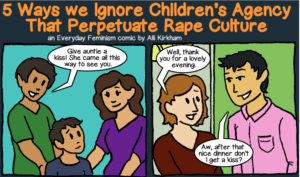
A smiling adult cuddling with two children on a sofa.
I grew up in a home with married parents who stayed that way until my mom’s death.
Despite this family model, when I found myself in a serious relationship well over a decade ago, and ever after deciding to have kids, marriage wasn’t on my mind.
For one thing, I had my concerns about the institution in general, and also about my access to it as part of an opposite gender couple in those pre-marriage equality days. Plus, I just couldn’t see how being married would make me any better at parenting.
But my concerns didn’t seem to be echoed in the messages about the importance of marriage that seemed to come at every turn. And those messages have stayed pretty consistent over the years.
Indeed, from reality TV shows that dangle marriage as a prize, to government initiatives supporting the institution, and even to a certain extent in the fight for marriage equality, the script has long stayed the same: Being married is crucial, especially when you have kids.
But is that really the case? Is marriage inherently a more worthy endeavor? And is it really all that much better for children?
Not necessarily. Research has demonstrated that when kids struggle, structural inequality is a far more likely culprit than their parents’ marital status.
That’s something that makes sense to me personally as someone who has parented with a partner to whom I wasn’t married, single parented, and also parented with a partner to whom I was married.
What I’ve experienced is that legal status didn’t make me any better at my job or make me more secure in a relationship, but what it did do was legitimize my family and provide an extra level of security.
But marriage alone often gets the credit when kids succeed, and the lack of it is often blamed when they don’t. This is a problem for a range of reasons, including the fact that marriage isn’t only undesirable for some couples, but is often also utterly off the table.
Plus, defaulting to the marriage explanation for healthy families misses the mark and doesn’t help us tackle the real issues that parents confront when trying to do their job.
So here are a few things we need to clear up about what really benefits kids, what really harms them, and why simply pushing marriage isn’t going to solve anything.
1. Marriage Is Becoming Increasingly Stratified
In recent, years, American marriage rates have been declining. There are a lot of reasons for this, including the fact that fewer and fewer people believe that marriage is a crucial lifecycle event – whether or not they have kids.
But there’s something else going on as well. Though declines have been seen across all demographics, in recent years, there have been larger marriage drops among some groups than among others. For one thing, poorer folks have been less likely to marry.
Why is this happening? It’s not simply a matter of different beliefs. Studies have found that there isn’t a big difference in the value and importance that people at lower income levels and those at higher ones place on marriage.
However, many poorer people report that they avoid marriage if they think they are unable to meet the standards of financial stability they believe are necessary to sustain a marriage.
Law professors June Carbone and Naomi Cahn explain this further in their book Marriage Markets:
“International and interstate comparisons demonstrate that higher rates of inequality tend to be associated with chronic unemployment, high rates of imprisonment, and substance abuse – factors that disproportionately affect men. Women in these communities view commitment to a man who runs up the credit card bill, cycles in and out of jobs, or deals drugs on the side as more of a threat than an asset to the ability to care for children.”
And while this is, of course, a straight- and binary-focused generalization, it can shine some light on why we’re seeing the current patterns in many communities.
But if marriage is a problematic institution to begin with – with its roots in patriarchy, and its imposition of one standard that socially and financially privileges married folks – then why does its decline even matter?
Partly, for all of those reasons.
Sociologists explain that in recent years, people have become more and more likely to marry someone with similar income and education levels. This means that rich people are marrying other rich people, and as a result, wealth is prevented from moving into different social classes.
Even the fight for marriage equality was, in many ways, a fight lead by upper-income folks.
As Steven Thrasher writes in a piece for Esquire called“Those Who Marriage Equality Left Behind,”
“Today, well-off LGBT[QIA+] people have become homeowners, wedding planners, and the coveted new target demographic of marketers. But this is not a reality for a class of the LGBT[QIA+] community for whom setting up a wedding registry comes far behind the specter of police violence, poverty, and HIV/AIDS. [Marriage] benefits a select few who express their love in a normalized way.”
The result of current marriage trends is that while marriage is less common than ever, it still manages to hold its place as the highest expectation of coupling.
This means that for many people in lower income brackets, marriage becomes an almost aspirational goal that they are punished for failing to achieve.
2. Being Unmarried Isn’t the Problem – Poverty Is
Okay, fine, even if you agree that marriage as an institution is problematic, hasn’t it been demonstrated that having married parents is just better for kids?
That’s often the default assumption, and it sure is the message you’d get if you were to look at a lot of recent headlines trumpeting the effect of marriage on children.
These would tell you that children with married parents are better-behaved, excel in school, have higher self-esteem, and basically, just plain old thrive.
But what if the headlines aren’t revealing the full story? And what if a lot of the studies they are based on are fueled by conservative agenda-driven organizations?
In reality, take a look at the article on better behaved kids. Read a little further into it, and you’ll learn that the research cited found that it wasn’t only married parents that were to be credited for kids’ composure. There were also the pretty significant issues of early education and family income.
And that whole children of married parents thrive thing? That was from a piece with a title promising to explain just why this was. But check out the article itself, and you’ll see that what leads to a child’s success is not only a parent’s marital status.
Factors like parents’ social status, wealth, and relationship history count just as much.
Still, marriage often gets the credit!
As researchers Kimberly Howard and Richard V. Reeves found, what’s often assumed to be a “marriage effect” is in all likelihood an “income effect” that reflects the benefits of having more money to put into things like better nutrition, better schools, and safer neighborhoods — all of which benefit kids.
Ultimately, the number one thing that we need to tackle in the United States in order to help children succeed is not declining marriage rates: It is poverty.
But fighting poverty in a country with some of the highest rates of wealth disparity around is a huge undertaking. What isn’t so daunting is simply promoting marriage, a long-standing and trusted institution.
This not only seems like a no-brainer, but when children have problems, it also shifts the blame to individual parents rather than to structural oppression – and that blame-shifting is one of our favorite ways to get out of really acknowledging and tackling serious injustice.
3. With the Right Support, Kids Can Succeed in a Range of Circumstances
While more and more couples across race and class lines are choosing to have children without being married, these families still have to contend with the default assumption that they are somehow doing their children a disservice.
Indeed, it’s not only the simple fact that plenty of unmarried, cohabiting parents are frequently lectured or queried about their status, professionals of all stripes, and often without a lot of data to back them, tend to take this tact.
Take Columbia University Social Work Professor Jane Waldfogel, for example. In an article on the rise of unmarried parents in the Wall Street Journal, she opined, “In terms of instability and uncertainty for kids, [cohabitation] is in some ways closer to single parenthood than it is to marriage.”
Somehow she manages to take a dig at a range of families in this comment without offering any proof!
Later in the article, another expert, Princeton Sociology Professor Sara McLanahan, explains of cohabiting parents: “There’s just a lot of complexity and instability in these households. There are enormous transaction costs involved in running a household like this, compared to just being a married-parent family and staying married.”
The article goes on to warn readers that “cohabiting parents are more likely to split up. When they do, they often form new partnerships, and have additional children, creating a complex web of half-siblings, step-parents, child-support payments, and family visits.”
This description sounds pretty familiar to me, as I’m sure it does to plenty of American families. But what I view as a rich and loving family system is simply disparaged here as a “complex web” without any nuance.
Such articles sound legitimate, quoting experts and parents alike. But when you dig a little deeper, it becomes clear that many of the dire warnings aren’t based on clear findings, but rather are assumption-driven conjectures that are justified by combining long-held views with spurious links to data.
Really, we are living in a time with the most diversity in family living arrangements in modern history.
Currently, 40% of all births are to unmarried people, with 59% of those kids being raised in households with cohabiting unmarried parents. Plenty of other children are living in families headed by single parents (a group who, when we talk about poverty and bias, are disproportionately affected). And we’re seeing a range of other families creating alternative structures as well.
So it’s high time we reexamine our understanding of the role marriage it still plays. Because, in a lot of ways, that role is still pretty large and still pretty compelling.
Indeed, despite my reservations about the institution, when I found myself in a serious relationship after my late partner’s death, marriage made the most sense.
In addition to deciding we wanted our relationship to be permanent, getting married meant my Canadian partner could move to the States. It meant that he could have a status with my kids beyond being just “Mommy’s boyfriend.”
And I knew that it meant more legal security, since I had discovered the hard way that navigating the fallout of my late partner’s death without the benefits of marriage made everything infinitely more complicated and painful.
But marriage shouldn’t be the most practical default, the gold standard of expectations, or an aspirational dream.
Instead of assuming marriage will solve everything, we need to offer paths out of poverty and towards education. We need to work on separating rights from this institution, and instead of cautioning about the effects on kids of unmarried parents. We need to be helping parents develop skills, push for subsidized daycare, and provide social supports for families of all shapes and sizes.
***
Throughout history, marriage was often a strategic endeavor and a means of consolidating family wealth and power. These days, marriage is often assumed to be an expression of love, commitment, and stability, and the healthiest structure under which to raise children.
But when we look a little closer, we might begin to realize that despite our romantic views, modern marriages often resemble their historic counterparts a little more than we’d like to admit. And when it comes to kids, a legal union between their parents isn’t the only way to guarantee their success.
Ultimately, what we need to do to help our children succeed isn’t manipulate data to prove that marriage is a cure-all.
Rather, we need to tackle inequality and poverty, which are actually the two most significant forces currently hurting kids in this country today, but which are also two of the most complicated and entrenched.
[do_widget id=’text-101′]
Ellen Friedrichs is a Contributing Writer for Everyday Feminism. She’s a health educator, sometimes writer, and mom. She has worked at Manhattan’s Museum of Sex, developed sex education curricula in Mumbai, India, and run HIV prevention programs for at-risk teens in the South Bronx. Currently, Ellen runs a middle and high school health education program and teaches human sexuality at Brooklyn College. More of Ellen’s writing can be found here. Follow her on Twitter @ellenkatef.
Search our 3000+ articles!
Read our articles about:
Our online racial justice training
Used by hundreds of universities, non-profits, and businesses.
Click to learn more




















